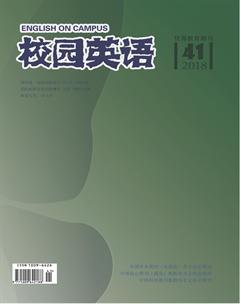Chinese Students’Difficulties in Learning English: from Phonology Perspective
【Abstract】Chinese is classified as a Sino-Tibetan Language, a family of tongue language in Asia, whereas English is a member of Indo-European language family, a family of inflectional languages. The marked phonological differences between these two languages impede the language learning process. This paper analyzes some frequently occurring phonological problems that Chinese students encounter when learning English.
【Key words】linguistic differences; phonology; learning difficulties
【作者簡介】沈轶(1987-),女,汉族,浙江宁波人,宁波大红鹰学院,硕士,讲师,研究方向:英语教学和第二语言习得。
One salient feature that distinguishes one language from another is the pronunciations of vowel sounds and consonant sounds. When ones vocal organs are fixed to produce sounds in one language, it requires a great deal of effort to get used to creating unfamiliar sounds in a new language, especially when the new language shares few similarities in pronunciation with the mother tongue. The number and articulation of consonants and vowels are different in English and Chinese. Due to the different phonological systems of Chinese and English, Chinese students encounter numerous difficulties in English pronunciation.
1. Problematic English Consonants
English interdental fricative consonants, [θ]and [?], are especially difficult for Chinese students. They usually substitute [s] for [θ], and replace [z] for [?]. The typical erroneous pronunciations mentioned by Thomas are “[s?nk] may be heard for thank… [wiz] for with” . Many students suffer from pronouncing these two interdental fricatives. When they learn to pronounce voiceless [θ], it is almost silent because the air stream is blocked by the tongue, while producing the voiced one, they feel their tongue and lips so itchy that they tend to retract their tongue unconsciously.
In addition, for some English consonants which have similar counterparts in Chinese consonants, Chinese students also have difficulties in pronouncing them. For example, the place and manner of articulation of alveolar nasal consonant [n] and velar nasal consonant [?] are similar in English and Chinese. Some Chinese can pronounce these two sounds accurately both in Chinese and in English; however, those from some particular dialect regions could not distinguish them neither in Chinese or English. For instance, they always substitute [n] for [?] both in Mandarin and English. Their pronunciation of 英(yīng)雄(xióng) (hero) sounds like yīn xióng; as for English words like sing, they pronounce [sin].
The third obvious mistake made by Chinese students is that they could not differentiate between voiced and voiceless consonants since the majority of Chinese consonants are voiceless, and the distinctive feature is whether the sound is aspirated or not. As a result, Chinese students tend to ignore the feature of voicing when producing English consonants. For example, with the voiced [?] substituted by the voiceless [?], leisure sounds more like [li??].
2. Problematic English Vowels
Vowel pronunciation is also a problematic area for Chinese students. One typical problem happens when students pronounce [i:] and [?] because there is no phonemic contrast between tense vowels and lax vowels in Chinese. When producing the-high-front-spread vowel [i:] in English, the tongue tends to glide upwards, but it keeps steady in its original position to pronounce the Chinese [i:]. They cannot differentiate the English [i:] and [?] in term of duration, not pronouncing and keeping English [i:] sound longer enough. For the English word beach, some Chinese students would pronounce it like [b?t?] (bitch) which might cause communication confusion and misunderstanding.
Another problem related to the vowel sound is shortening the English diphthongs. The typical troublesome English diphthongs for Chinese speakers are [a?] and[??]. Since neither [?] sound nor [?] sound exists in Chinese, difficulty is increased when Chinese students produce these two English diphthongs. For example, down town is always pronounced as [da:n ta:n], oil as [?:l]
The third obvious error made by Chinese students is the additional [?] after the word-final consonant or between the nonsyllabic consonant in a cluster. This phenomenon is triggered by the feature of Chinese as a syllable-timed and tone language. Chinese speakers tend to make more syllables or make the syllable tonic by extending the length of the syllable because Chinese morphemes generally consist of a consonant plus a vowel with no consonants cluster and usually end with a vowel. Negatively transferring this character of Chinese phonological rules to English, learners would commonly pronounce words book and bed as [buk?] and [bed?].
Mandarin Chinese focuses on the syllable and each syllable takes the same amount of time to produce. It is tone, or the pitch level of each syllable that determines the word meaning. In contrast, English is stress oriented, and the stressed syllable takes longer time than the unstressed one. Meanwhile, English utterances depend on certain intonations to express different meanings, but they do not depend on tone. A metaphor which vividly illustrates the difference of Chinese and English is “Chinese sentences are like a number of beads strung together, which makes it easier for listeners to distinguish one phoneme from another; while English sentences are like water streams which flow smoothly though they have ripple on the surface”. Without such knowledge, Chinese speakers always try to pronounce each syllable in English word loudly and clearly so that they ignore intonations and junctures. As a result, their English sounds so weird to native speakers, or even cause misunderstanding.
3. Conclusion
The linguistic differences of Chinese and English which belong to two different language families cause Chinese students difficulties when learning English as a foreign language. The phonological problem is the inaccurate pronunciation of some consonants and vowels, such as interdental fricatives [θ]and [?], nasal [n] and [?], and voiced consonants. The problematic vowel pronunciations are [i:] and [?] as well as diphthongs [a?] and [??]. Chinese students also intend to additional [?] after the word-final consonant or between the nonsyllabics of cluster. Moreover, they make errors in English syllable, stress, intonation and juncture.
References:
[1]Thomas,C.K.Chinese difficulties with English pronunciation[J]. Journal of Speech and Hearing Disorders,1939,4:255-259.
[2]Tiee,H.Contrastive analysis of the monosyllabic structure of American English and Mandarin Chinese[J].Language Learning, 1969,19(1&2):1-15.
[3]Zhao,F&Yin;,P.A study of pronunciation problems of English learners in China[J].Asian Social Science,2009,5(6):141-146.

